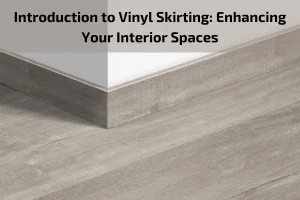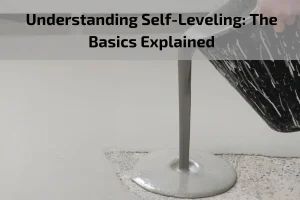When it comes to interior design, every detail counts, including elements that may often go unnoticed, such as skirting boards. PVC skirting, though primarily functional, offers a wealth of creative opportunities to enhance the overall aesthetic of your interior spaces. In this exploration of “Creative Design Ideas with PVC Skirting: Enhancing Your Interior Décor,” we delve into innovative ways to elevate your design scheme while embracing the practicality and versatility of PVC skirting.
PVC skirting boards, traditionally known for their durability and ease of maintenance, have evolved beyond their functional role to become integral components of interior design. With a wide range of styles, colors, and profiles available, PVC skirting boards offer endless possibilities for adding character, texture, and visual interest to your spaces.
In this guide, we’ll uncover how PVC skirting can serve as more than just a functional element, but as a design feature that ties your interior scheme together. From subtle accents to bold statements, PVC skirting opens doors to creativity and innovation, allowing you to personalize your space in ways that reflect your unique style and personality.

Types of PVC Skirting
PVC skirting comes in several types, each designed for specific applications and aesthetic preferences. The most common type is standard PVC skirting, which features a simple, straight profile ideal for minimalist and contemporary interiors. It offers a clean and seamless appearance that complements any flooring type.
Flexible PVC skirting is another popular variety. It bends easily to fit curved walls or irregular surfaces, making it perfect for areas where standard rigid skirting cannot be used. This flexibility allows for quick installation without cutting or joining multiple pieces.
Decorative PVC skirting mimics the appearance of natural materials like wood, marble, or stone, providing a luxurious finish without the high cost or maintenance. These styles are ideal for homeowners seeking a warm or elegant ambiance while maintaining durability and resistance to moisture.
There’s also cable management PVC skirting, which features hollow sections that allow wires and cables to be hidden neatly inside. This is commonly used in offices, conference rooms, or entertainment spaces to keep electrical systems organized and concealed.
Finally, self-adhesive PVC skirting offers the easiest installation method. It uses pre-applied adhesive backing that sticks directly to walls or floors, saving time and effort. With such variety, users can choose the type that best fits their design vision and functional needs.
Advantages of Using PVC Skirting
PVC skirting offers multiple advantages over traditional materials, making it a top choice for modern interiors. First and foremost, it is highly durable. Unlike wood, PVC does not rot, warp, or swell when exposed to moisture. This makes it ideal for humid environments such as kitchens, bathrooms, and basements.
Another significant advantage is low maintenance. PVC skirting requires minimal care — simple cleaning with a damp cloth keeps it looking new. It does not need polishing, repainting, or refinishing, saving time and maintenance costs.
PVC is also cost-effective, providing a budget-friendly solution without compromising quality or style. Its easy installation further reduces labor expenses. Additionally, it is lightweight and safe to handle, which simplifies transportation and fitting.
From an aesthetic perspective, PVC skirting enhances interior design by offering a sleek, uniform edge that hides imperfections and provides a professional finish. It also improves hygiene by preventing dust and dirt from collecting in wall-floor joints.
Moreover, PVC is eco-friendly when produced using modern recycling methods, as it can be reprocessed and reused. Its resistance to termites, mold, and stains ensures long-lasting performance, making it an excellent choice for both residential and commercial projects.
How to Install PVC Skirting
Installing PVC skirting is a straightforward process that can be done by professionals or DIY enthusiasts. The first step is to measure the room’s perimeter accurately to determine how much skirting material is needed. It’s always advisable to purchase slightly more than required to account for mistakes or adjustments.
Before installation, the wall surface should be clean, dry, and smooth. Any debris or dust may prevent proper adhesion. For adhesive-backed skirting, peel off the protective strip and press the skirting firmly along the wall, ensuring even alignment. For non-adhesive skirting, apply a suitable construction glue to the back of each piece and press it onto the wall.
When dealing with corners, use a miter saw or cutter to make precise angled cuts for seamless joints. Flexible PVC skirting can easily bend around curved surfaces without cutting. For cable management skirting, place the wires inside the designated channel before securing the cover.
After installation, inspect the edges and joints to ensure everything is firmly fixed. The process usually takes only a few hours, depending on the room size. PVC skirting’s simplicity, combined with its professional appearance, makes it a favorite for modern interior finishing.
Maintenance and Cleaning Tips
PVC skirting is known for its minimal maintenance requirements, but proper care can extend its lifespan and preserve its appearance. Regular cleaning is key to preventing dirt buildup. Simply wiping the skirting with a soft cloth or sponge dipped in mild soap and water is enough to maintain its shine.
Avoid using abrasive cleaners, scouring pads, or harsh chemicals that might dull or damage the surface. For stubborn stains, a gentle plastic-safe cleaner can be used. In offices or homes with frequent cleaning activities, make sure that vacuum or mop heads do not scratch the skirting surface.
If adhesive-backed skirting begins to loosen over time, it can easily be re-secured using additional adhesive. Damaged sections are also simple to replace without affecting the entire installation.
For cable-hiding skirting, periodically check that wires remain properly enclosed to maintain neatness and safety. PVC skirting is water-resistant, so it can be cleaned even in wet environments without the risk of swelling or peeling.
With basic maintenance, PVC skirting can retain its original look for years, proving to be a practical and durable finishing solution for all types of spaces.
PVC Skirting in Modern Interior Design
In modern interior design, PVC skirting plays a subtle yet essential role in defining the overall look of a space. Its sleek and minimal appearance aligns perfectly with contemporary styles that prioritize clean lines and functionality. Designers use PVC skirting to create smooth transitions between floors and walls, adding a polished and professional touch.
The wide range of finishes — from matte and gloss to wood grain or marble effects — allows PVC skirting to complement any flooring or wall color scheme. It provides designers with creative flexibility while maintaining practicality.
In open-plan layouts, PVC skirting helps visually separate areas without the need for additional architectural elements. It can also be used as a framing detail that accentuates interior proportions.
Furthermore, PVC skirting supports the current trend of hidden functionality. Cable management designs allow modern interiors to remain clutter-free and technologically integrated without sacrificing aesthetics. Whether in a luxurious apartment, minimalist office, or cozy home, PVC skirting contributes to the harmony and balance that define contemporary spaces.
Comparing PVC Skirting with Wooden Skirting
When comparing PVC skirting to wooden skirting, several differences stand out. Durability is one of the main factors — wood is prone to damage from moisture, termites, and warping, while PVC remains unaffected by such issues. This makes PVC ideal for humid climates or areas exposed to water.
PVC is also more affordable than wood, both in material and installation costs. Wooden skirting requires sanding, painting, and periodic maintenance, whereas PVC maintains its appearance with minimal care.
From an environmental perspective, PVC can be recycled, whereas wooden skirting often involves cutting down trees, impacting sustainability. However, some prefer wood for its natural warmth and classic appeal.
Design-wise, PVC offers greater versatility. It can imitate wood, stone, or metallic finishes, giving homeowners the freedom to achieve various styles at a lower price. Wooden skirting, while traditional, limits color options and may not suit all modern interiors.
Ultimately, PVC skirting is the more practical choice for long-term durability, affordability, and ease of maintenance, while wood remains a premium aesthetic option for those seeking a natural touch.
Applications of PVC Skirting
PVC skirting is used across a wide range of environments due to its versatility. In residential spaces, it provides a neat finish for living rooms, bedrooms, and kitchens, complementing various flooring materials. Its water resistance makes it perfect for bathrooms and laundry areas.
In commercial settings, such as offices, hospitals, and retail stores, PVC skirting is favored for its durability and hygiene benefits. It prevents dirt accumulation, facilitates cleaning, and withstands heavy foot traffic. The cable management option also allows safe electrical organization in workplaces.
In industrial spaces, PVC skirting is used for safety and cleanliness, protecting walls from equipment impacts and simplifying maintenance.
Hotels, schools, and public buildings also utilize PVC skirting for aesthetic consistency and longevity. Its availability in different heights and finishes allows customization to match the interior’s purpose and design.
Whether for functional or decorative purposes, PVC skirting proves to be a reliable, cost-effective, and durable choice across all sectors.
Eco-Friendly Aspects of PVC Skirting
While PVC is a synthetic material, advancements in technology have made its production and recycling processes more eco-friendly. Many modern manufacturers now use recycled PVC and lead-free stabilizers, reducing environmental impact.
PVC skirting’s longevity also contributes to sustainability, as it does not need frequent replacement like wood or MDF. Its resistance to moisture, termites, and mold minimizes waste generation and resource consumption over time.
Additionally, since PVC skirting can be fully recycled, old or damaged sections can be repurposed into new materials. Some brands even offer take-back programs to ensure responsible recycling.
Compared to wooden skirting, which involves deforestation and requires frequent repainting or refinishing, PVC’s environmental footprint is often smaller when managed properly. Choosing eco-certified PVC products is an effective way for consumers to support sustainability while enjoying modern design benefits.
Customization and Design Options
PVC skirting is available in a wide variety of styles, colors, and textures to match any interior design theme. From sleek minimalist designs to textured wood-like patterns, there’s an option for every taste.
Manufacturers also provide custom color matching, enabling designers to coordinate skirting with specific wall or floor finishes. Some models feature metallic trims, LED lighting channels, or unique curved profiles for added elegance.
The flexibility of PVC as a material allows for intricate molding and precision cutting, offering limitless design possibilities. Businesses can even brand their interiors with custom-embossed skirting for a professional appearance.
With so many design options, PVC skirting provides not just protection but also an opportunity to express creativity and elevate the look of any space.
Common Mistakes to Avoid with PVC Skirting
Despite its simplicity, several mistakes can occur during the installation or maintenance of PVC skirting. One common error is improper surface preparation — installing on dusty or uneven walls can cause poor adhesion and detachment over time.
Using the wrong adhesive can also lead to weak bonding or surface damage. Always select adhesives designed for PVC or follow the manufacturer’s recommendations.
Cutting skirting inaccurately, especially around corners, leads to visible gaps and uneven edges. Professionals recommend using a miter box or corner connectors for precise fitting.
The most important frequently asked questions about PVC Skirting
What is PVC skirting?
PVC skirting is a decorative and protective board installed along the base of interior walls.
What is PVC skirting used for?
It protects walls from damage and hides the joint between the wall and floor.
Can PVC skirting be used in bathrooms?
Yes, it’s ideal for bathrooms and kitchens due to moisture resistance.
How is PVC skirting installed?
It can be fixed with adhesive, screws, or clips depending on the design.






